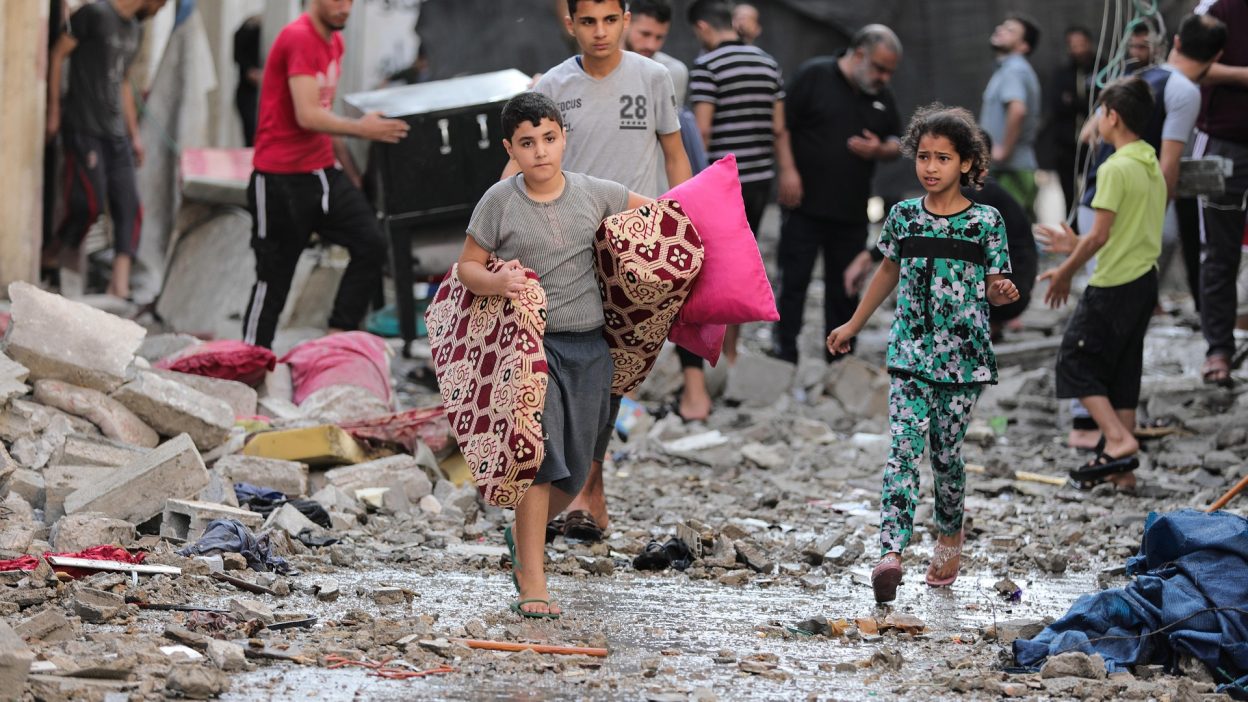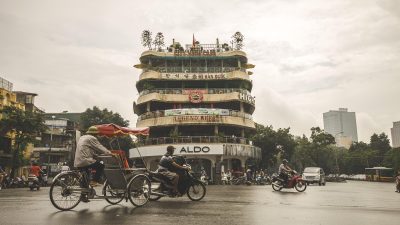How Government Failure and a Volcanic Disaster Killed 23,000 in a Single Night
Introduction: A Town Erased in a Single Night
On the night of 13th November 1985, the Colombian town of Armero ceased to exist. It was neither an earthquake nor a war that obliterated it—it was a wave of scalding volcanic mud, moving with the force of an unstoppable tsunami. At 11:30 PM, nearly 23,000 people were buried alive beneath a choking mass of debris, ash, and water. Homes, schools, hospitals—everything was swallowed whole within minutes. Survivors described hearing an otherworldly roar before an unstoppable wall of destruction consumed their town. Armero, once a thriving agricultural centre, was turned into a silent graveyard in the dead of night. The most horrifying truth? This disaster was entirely preventable—and thousands of innocents lives were lost due to a catastrophic failure of leadership.
At the heart of this tragedy stood Nevado del Ruiz, a snow-capped volcano that had been sending warnings for months. Scientists had repeatedly cautioned Colombian authorities about the imminent danger of a lahar—a fast-moving volcanic mudflow triggered by an eruption. Evacuation plans were proposed, risk maps were drawn, but no action was taken. The government’s indifference sealed the town’s fate, leaving its residents completely unaware of the death wave racing towards them at nearly 37 mph (60 km/h). By the time the mud, ash, and boulders slammed into Armero, it was too late. Thousands died in their sleep. Families were torn apart in an instant, their screams drowned out by the relentless force of nature and human negligence combined.
Among the many haunting images that surfaced from the tragedy, none were more gut-wrenching than the final hours of Omayra Sánchez, a 13-year-old girl trapped in the rubble, slowly succumbing to her injuries as the world watched helplessly. Her suffering became the face of this catastrophe, a grim reminder of what happens when warnings are ignored. The Armero Tragedy was not just a natural disaster; it was a man-made catastrophe—a lesson written in blood, yet still not fully learned.
The Volcano That Gave a Warning
For decades, Nevado del Ruiz stood as a towering, snow-capped giant in the Andes, seemingly dormant but hiding a deadly secret beneath its icy peak. Dubbed the “Sleeping Lion”, the volcano had erupted multiple times in recorded history, each time triggering devastating mudflows. Scientists knew its potential for destruction—so when plumes of ash and seismic tremors began in early 1985, volcanologists across Colombia and beyond sounded the alarm. They warned that even a moderate eruption could melt the glacier at its summit, releasing a violent cascade of mud and debris capable of wiping entire towns off the map. But their warnings fell on deaf ears. The Colombian government hesitated, downplaying the risks. Officials refused to implement mass evacuations, believing the threat to be exaggerated.
Then, on the night of 13th November, their worst fears became reality. At 9:09 PM, Nevado del Ruiz erupted, sending a 10-kilometre (6-mile) column of ash and molten rock into the sky. The heat from the eruption instantly melted the glacier, forming a monstrous lahar—a roaring torrent of mud, ice, and debris the size of a skyscraper. The lethal sludge, now mixed with volcanic ash and boulders, accelerated down the slopes at 60 km/h (37 mph), growing in volume as it swallowed rivers and streams along the way. By the time it reached Armero, two hours later, it had transformed into a monstrous 40-metre (130-foot) tidal wave of death. The town, which should have been evacuated months earlier, was caught in the crosshairs of a disaster no one had been prepared for—despite having all the warnings they needed.
A Government’s Criminal Negligence
The Armero Tragedy was not just a natural disaster—it was a failure of leadership so profound that it cost 23,000 lives. Months before the eruption, scientists and geologists had repeatedly warned that Nevado del Ruiz posed an imminent threat. Reports detailed how even a small eruption could unleash deadly lahars, yet government officials dismissed these concerns as exaggerated fear-mongering. In September 1985—two months before the catastrophe—experts from the Colombian Institute of Geology and Mining (INGEOMINAS) had even created hazard maps showing Armero’s extreme vulnerability. The maps clearly marked the town as a high-risk zone, but instead of distributing them to residents, officials left them in bureaucratic limbo, unseen and unused. When local leaders requested evacuation plans, they were met with political delays, red tape, and apathy. The government’s stance was clear: an evacuation would be expensive, unnecessary, and would create unnecessary panic.
This negligence turned deadly on the night of 13th November 1985. Even after the volcano erupted at 9:09 PM, no emergency alarms were sounded, and no evacuation orders were issued. Officials in Bogotá failed to communicate the urgency of the situation, leaving the people of Armero completely unaware of the incoming catastrophe. By the time the first lahar struck at 11:30 PM, thousands were still in their homes, asleep or waiting for government instructions that never came. When the mudflow finally swallowed the town, it wasn’t just volcanic fury that killed 23,000 people—it was human failure. Armero’s destruction wasn’t an unpredictable act of nature; it was a massacre by incompetence.
A Timeline of Destruction
At 9:09 PM, when Nevado del Ruiz erupted, its fiery blast was visible for miles, but in Armero, no one knew their fate had already been sealed. The town remained eerily calm, with most residents indoors, oblivious to the catastrophe racing towards them. At 10:30 PM, the first lahar—an avalanche of boiling mud, ash, and boulders—began its deadly descent. It picked up speed, swallowing rivers, uprooting trees, and tearing through the Andean valleys. No sirens blared, no warnings were issued. The government had failed to establish any real-time communication, leaving the people of Armero defenceless. At 11:30 PM, the lahar arrived like a silent executioner, a churning, suffocating wave over 130 feet (40 metres) high. The ground trembled as the first surge engulfed the lower parts of town, slamming into homes, schools, and hospitals with unstoppable force.
Panic erupted as people woke up to the deafening roar of destruction. Families ran, but there was nowhere to go—the mud moved at 37 mph (60 km/h), faster than anyone could escape. Entire neighbourhoods were swallowed in seconds. Screams were drowned beneath the thick, suffocating sludge. Buildings collapsed, trapping thousands under layers of volcanic debris. Those who weren’t crushed slowly suffocated, buried alive in the toxic, cement-like mud. The lucky few who climbed onto rooftops or trees could only watch in horror as their loved ones vanished beneath the flood of death. By sunrise, 80% of Armero was gone, reduced to an unrecognisable wasteland. What had been a town of 29,000 was now a mass grave. The tragedy wasn’t just in the numbers—it was in the agonisingly slow, preventable deaths of thousands who never should have been there in the first place.
The Iconic Tragedy of Omayra Sánchez
Among the thousands of heartbreaking deaths in Armero, one face came to define the disaster: Omayra Sánchez, a 13-year-old girl whose slow, agonising death was broadcast to the world in real time. When the lahar tore through her home, Omayra was trapped beneath the wreckage of her house—her legs pinned under concrete and debris. Rescuers found her partially submerged in freezing, filthy water, her lower body hopelessly stuck. For nearly 60 hours, she fought to survive as journalists, photographers, and television crews captured her suffering. But despite global attention, there was nothing anyone could do. Rescuers lacked the equipment to free her, and the government’s response was too slow, too unprepared, too incompetent. Doctors warned that even if they could lift her out, the shock and trauma from the injuries would kill her instantly.
As time passed, Omayra’s strength faded. Her eyes darkened, her breath grew weaker, yet she remained composed, even speaking to reporters about her dreams and fears. The world watched in horror as this innocent child, abandoned by the very people who should have saved her, slipped away before their eyes. On 16 November 1985, she succumbed to hypothermia and gangrene. The haunting final image of her—her dark, exhausted eyes staring straight into the camera, her lips cracked, her body trapped in a watery grave—became a symbol of government failure, human suffering, and a preventable catastrophe. Omayra did not die because of a natural disaster; she died because no one had cared enough to prepare.
The Death Toll: Unforgivable Losses
• 23,000 Lives Lost
The official death toll of the Armero Tragedy stands at over 23,000 people, making it one of the deadliest volcanic disasters in history. Entire families were wiped out, buried under thick layers of mud and ash. The exact number may never be known, as many bodies were never recovered, forever entombed beneath the hardened volcanic debris.
• Over 5,000 Children Killed
The tragedy was especially brutal for the youngest residents of Armero. More than 5,000 children perished, many of them asleep when the lahar struck. Survivors recall the haunting cries of trapped children slowly fading away as the mud hardened around them, making rescue impossible.
• More Than 5,000 Injured
Thousands who managed to survive suffered from severe burns, broken bones, infections, and suffocation injuries caused by inhaling toxic volcanic ash. With emergency response efforts chaotic and disorganised, many died due to a lack of medical aid, as hospitals were either destroyed or completely overwhelmed.
• Thousands of Bodies Never Found
The lahar buried Armero under 5 metres (16 feet) of thick mud, making body recovery efforts nearly impossible. To this day, thousands remain missing, their bodies permanently trapped beneath the hardened volcanic sludge. Even decades later, families still mourn the loss of loved ones who were never given a proper burial.
• The Armero Orphans: Survivors Left Without Families
In the aftermath, hundreds of children were left orphaned, having lost their entire families in the mudslide. Many of them were adopted by strangers or placed in orphanages, forced to rebuild their lives without parents, siblings, or a home to return to. The psychological scars of that night remain with them even today.
A Disaster That Should Have Changed the World
When the sun rose over what was once Armero, it revealed a nightmare frozen in time—a town that no longer existed. The landscape was unrecognisable, a sea of lifeless mud stretching for miles. Bodies, buildings, and memories lay buried beneath a hardened shell of volcanic debris. Survivors wandered aimlessly, covered in ash and filth, searching for children they would never find, homes that no longer stood, families that no longer existed. The silence was deafening—no birds, no voices, only the occasional muffled cry from someone trapped beneath the suffocating sludge. But the real horror? The world could have stopped this from happening.
The Colombian government’s response was slow, uncoordinated, and utterly disgraceful. When survivors desperately needed help, aid was stuck in bureaucratic chaos. Helicopters and rescue teams arrived too late, with no proper equipment to dig through the hardened mud. Injured victims lay untreated for days, suffering from infections, dehydration, and exposure. Supplies sent by other countries piled up in airports, tangled in red tape and government inefficiency. As global outrage grew, officials scrambled to shift blame—but no excuse could erase the truth: thousands had died because of a failure to act.
And yet, the world moved on. The tragedy made headlines, the images of Omayra Sánchez haunted television screens, but nothing truly changed. Years later, volcanic eruptions in other parts of the world would still claim lives due to poor disaster preparedness. Governments still gamble with human lives, ignoring warnings in favour of convenience and cost-cutting. Armero should have been a wake-up call. Instead, it became just another tragedy written in blood—forgotten by all except those who lost everything.
Lessons from Armero
The horrifying truth of the Armero Tragedy is that it could happen again, and in many places, it already is waiting to strike. Are we really prepared? The deadly combination of human negligence and nature’s fury isn’t something confined to the past—it’s a disaster still lurking at the edges of many vulnerable communities around the world. Volcanic eruptions continue to pose a serious threat in regions where people live in the shadow of active volcanoes, but many governments are still failing to act swiftly or adequately. Despite technological advancements in early-warning systems and disaster management, incompetence, underfunded agencies, and bureaucratic delays still leave entire populations exposed to the same deadly risks that destroyed Armero. The horrifying reality is that today’s Armero could be just as preventable—if we actually learn from the mistakes of the past.
The world must wake up to the warning signs. The systems are in place, but are the governments and organisations willing to take the necessary actions in time? Will they wait until another town is buried, until another Omayra Sánchez is caught in the mud, until more innocent lives are lost because no one listened when they should have? The Armero disaster showed us what happens when inaction and denial are allowed to continue. It showed us that if we don’t prepare now, the next tragedy won’t be a warning—it will be another irreversible loss.
Conclusion
The Armero Tragedy serves as a haunting reminder of the cost of government negligence and the failure to heed scientific warnings. It wasn’t just nature that killed over 23,000 people—it was human incompetence, a disaster that could have been avoided with timely action and proper preparedness. The world must remember Armero—not just as a tragedy, but as a glaring lesson in the need for effective disaster response and proactive measures. If we fail to act now, another Armero could be waiting around the corner, ready to claim even more lives. The time for change is now, before it’s too late.
FAQ: Armero Tragedy 1985
- What caused the Armero Tragedy?
The Armero Tragedy was caused by a volcanic eruption of Nevado del Ruiz, which triggered a massive lahar (volcanic mudflow) that engulfed the town.
- How long did it take for the lahar to reach Armero?
The lahar struck Armero about two hours after the eruption, at approximately 11:30 PM on November 13, 1985.
- Why were people not evacuated before the eruption?
Despite repeated warnings from scientists, the Colombian government failed to take action, believing the danger was overstated and delaying evacuation orders.
- How did Omayra Sánchez become a symbol of the tragedy?
Omayra Sánchez became a tragic symbol due to her agonising death, trapped under debris for over 60 hours while the world watched her struggle to survive. - Are there any memorials for the victims of Armero?
Yes, there are memorials in Armero and surrounding areas to honour the victims, though much of the original town remains destroyed, and the tragedy is commemorated annually.
References
The Armero Tragedy – A Historical Overview
https://en.wikipedia.org/wiki/Armero_tragedy
Colombia: 1985 Nevado del Ruiz Eruption
Armero Tragedy Photos
How the Armero Tragedy Changed Volcanology in Colombia
YouTube links
The Armero tragedy
Told to Stay At Home: The Armero Disaster 1985 | Plainly Difficult | Short Documentary
Armero Tragedy
The forgotten Colombian city destroyed by a volcano – BBC REEL




